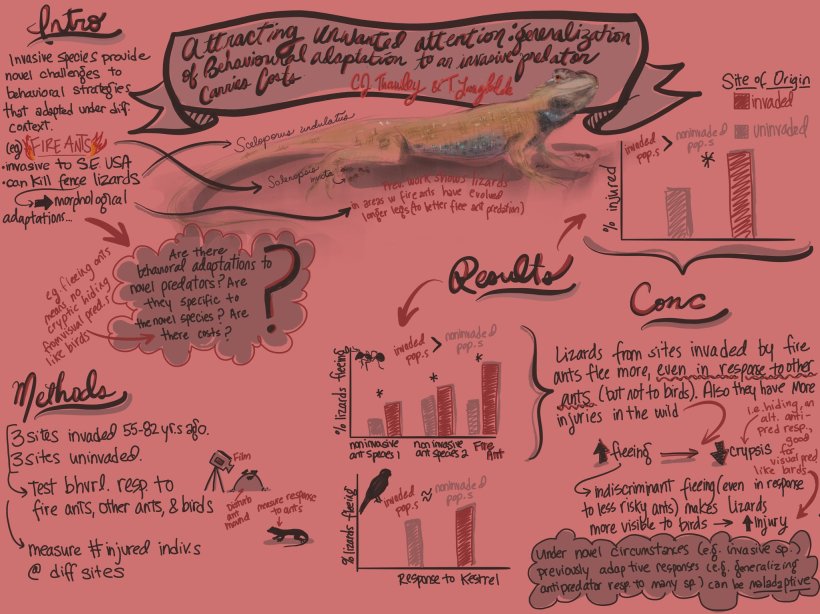I’ve certainly attracted my share of unwanted attention: missing a key free throw in a basketball game when everyone in the crowd was watching, faceplanting while exiting stage right in A Midsummer Night’s Dream, or unconsciously ripping a huge burp at a fancy dinner. Fortunately, as a human, the stakes involved in these mistakes were fairly low: a little embarrassment and a good story once the shame had worn off. For many organisms, like lizards, however, attracting unwanted attention in the real world can have serious consequences…
From previous research in the Langkilde Lab, we know that invasive fire ants (Solenopsis invicta) can pose a serious danger to native fence lizards (Sceloporus undulatus), and that fence lizards from areas invaded by fire ants respond to encounters with these ants with a variety of twitches and scratches to remove ants as well as fleeing more often to escape them.
We know little, however, about the behavioral rules that govern fleeing and twitching in these lizards. Do they flee more from all predators? Do they flee from all ants? We know the benefit of twitching and fleeing (not getting stung!), but is there any cost to these behaviors? Because we’re ecologists, we looked to answer these questions by conducting a series of experiments and published them in Animal Behaviour.
So, do fence lizards from fire ant-invaded areas flee more from other predators? Because we couldn’t let actual predators attack our lizards, I borrowed a stuffed kestrel (Falco sparverius, a well-known predator of fence lizards), rigged it with a wire harness, attached some very serious and scary-looking eyes, and swung it at unprepared fence lizards to see what their reactions would be.
We found that fence lizards from sites with and without fire ants fled from simulated kestrel attacks the same proportion of the time, and with the same strength and latency (reaction time), suggesting that fence lizards exposed to fire ants don’t flee more from all predators.
We next tested our fence lizards’ reactions to fire ants (which we’ve done before) as well as two types of native ants which might annoy lizards by running on them, but lack the venom (and danger) of fire ants. In fact, these native ants are important sources of food for fence lizards under normal circumstances. In these tests, we found that fence lizards from sites with fire ants fled more from all types of ants, not just fire ants, indicating that this fleeing behavior is generalized to multiple types of ants that they encounter, including those that don’t pose a serious danger.
For the more visually oriented, this series of experiments was illustrated super-well by Tali Hammond, a behavioral ecologist, who was interested in the paper (check out that sweet Sceloporus!)

Check out more illustrated papers by Tali: @mammalLady
So what might the consequences of this generalization be for fence lizards? For one, it’s obviously not ideal to be running away from something (i.e., native ants) that isn’t a threat and should be a meal. This could result in lower food intake or time wasted running away from non-dangerous ants, though we haven’t tested for these effects. More dramatically, twitching and fleeing break crypsis, a lizard’s primary defense against its visually hunting predators, including snakes, and birds of prey like the kestrel. While fence lizards are usually quite well camouflaged, imagine how easy it might be for a predator to spot a lizard jerking around as in the video above. We looked for evidence of this cost in our lizards by quantifying the amount of injuries (broken tails, scars, missing limbs) to lizards at sites with and without fire ants.
We found that lizards from sites with fire ants do indeed have more of these injuries than lizards at sites without fire ants. This result suggests that fleeing from fire ants might attract unwanted attention from other types of predators. And when we consider that these lizards also flee more from native ants, which are common in the environment, these antipredator behaviors might have a serious drawback. It is important to note that this evidence is circumstantial; we didn’t see predators preying on lizards running from ants (this would be very difficult), and there could be other explanations for this pattern, such as differences in predator communities, or perhaps differing skill levels of predators. However, this work suggests that lizard that twitch and flee in response to ants may be attacked more.
So why do we see this behavior if it has these drawbacks? My personal guess is that it comes down to consequences. As a human, the consequences of my unwanted attention were fairly minor (shame). The stakes for fence lizards are a bit higher: fleeing can lead to running from your own dinner or attracting attention from predators. BUT the costs of not fleeing when attacked by fire ants are likely even higher (serious injury or death). And in many areas fire ants are much more common and likely to interact with lizards more frequently than snakes and kestrels. In other words, the lizards are likely making the best choice available to them. In the future, perhaps, they will adapt to distinguish between dangerous and native ants, allowing them to make more optimal decisions, and reduce the costs of these antipredator behaviors. More broadly speaking, I believe this research shows that we need to consider a wide variety of potential costs as well as benefits when looking at organisms adapting to changes in their environments.


